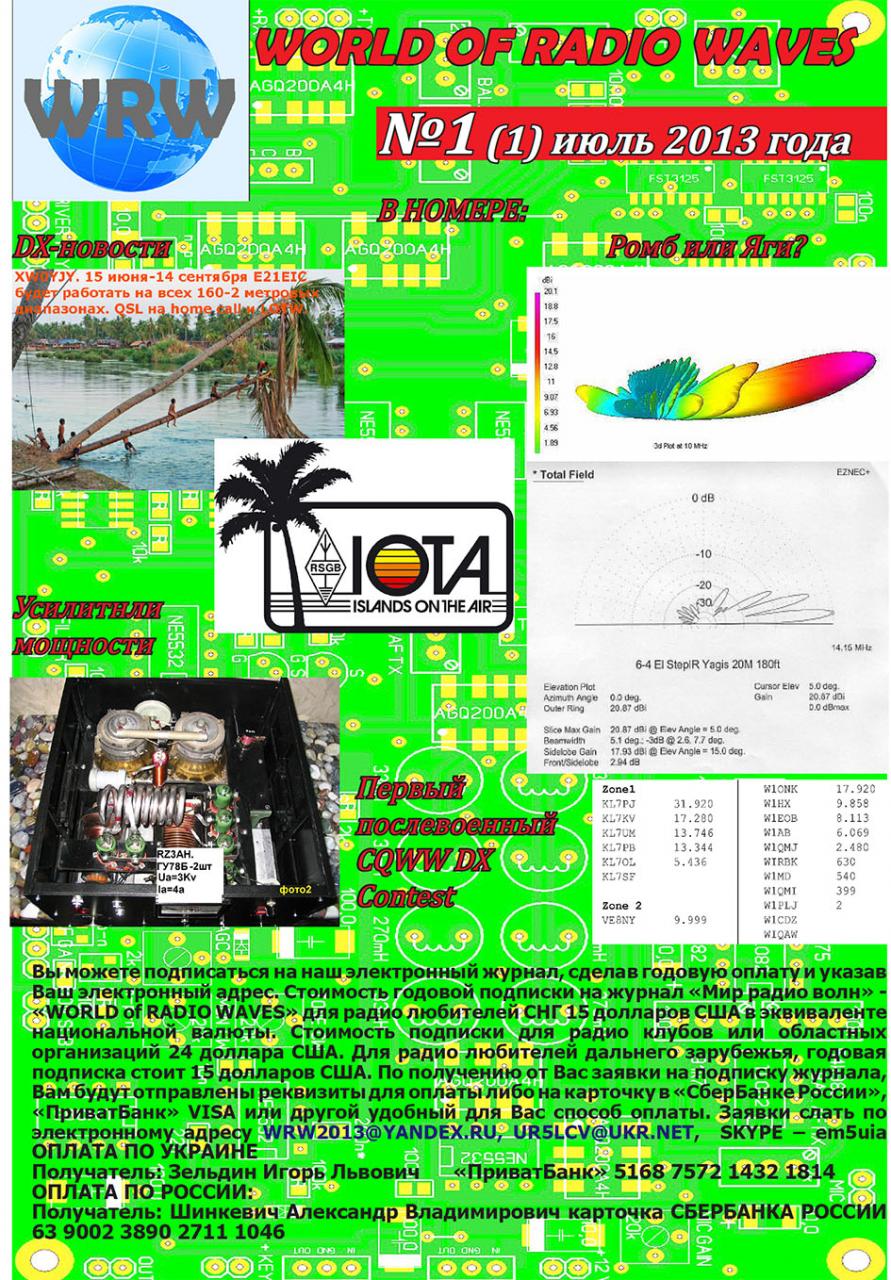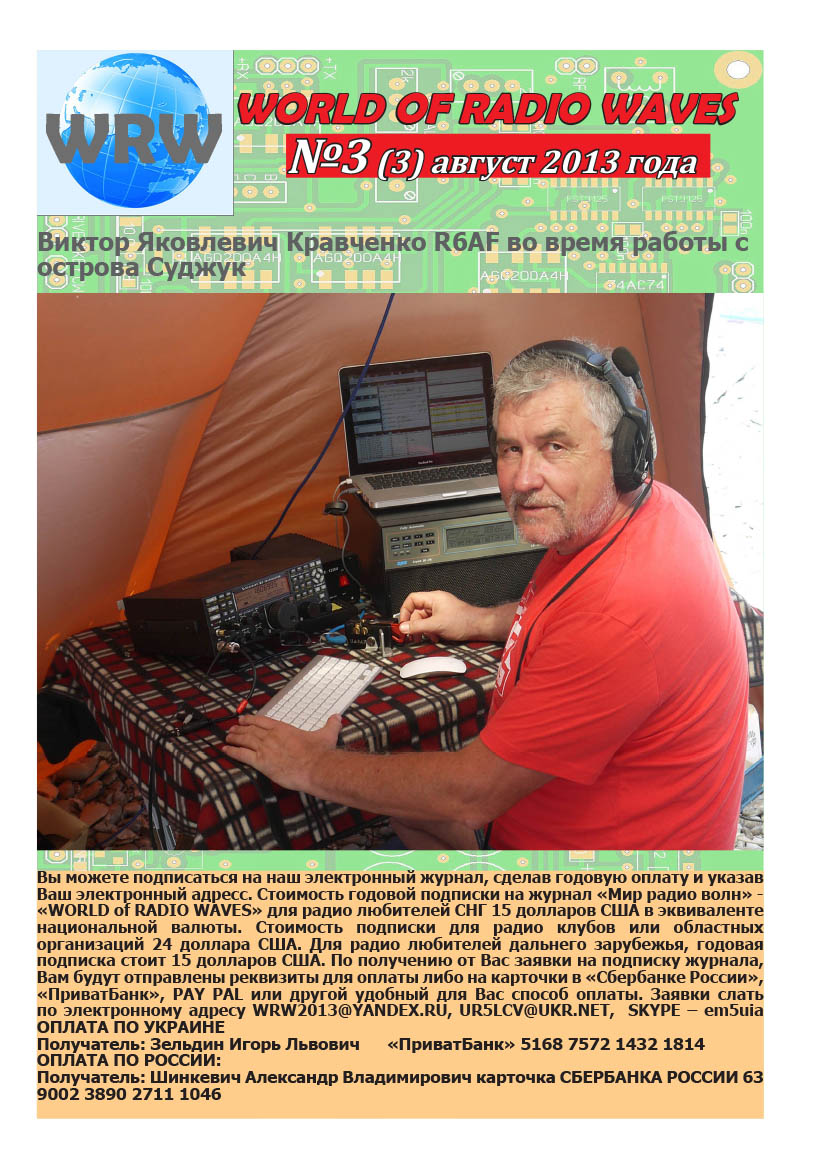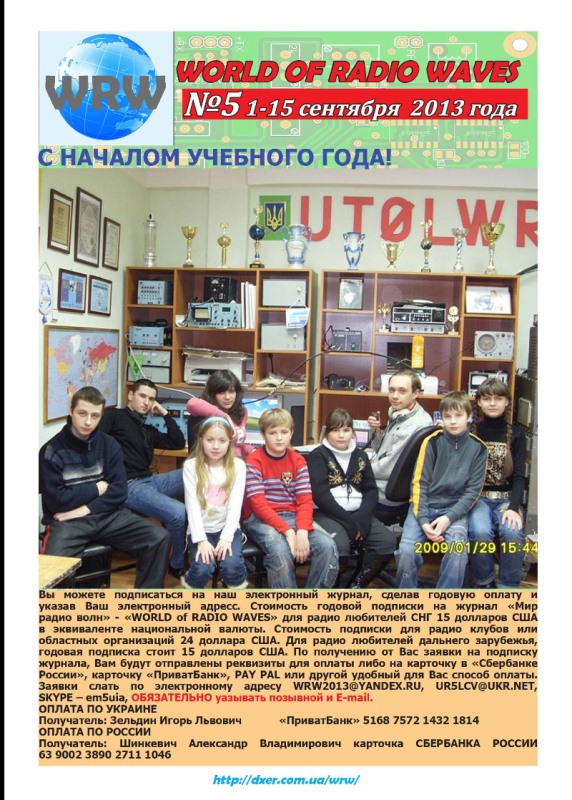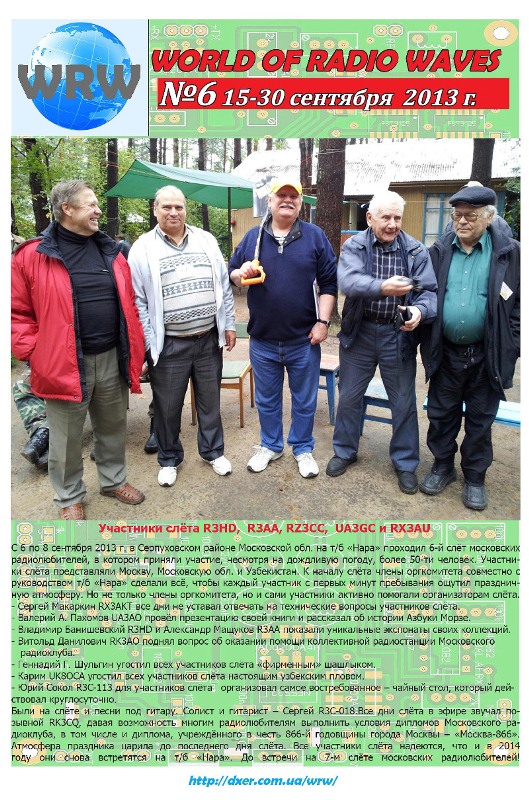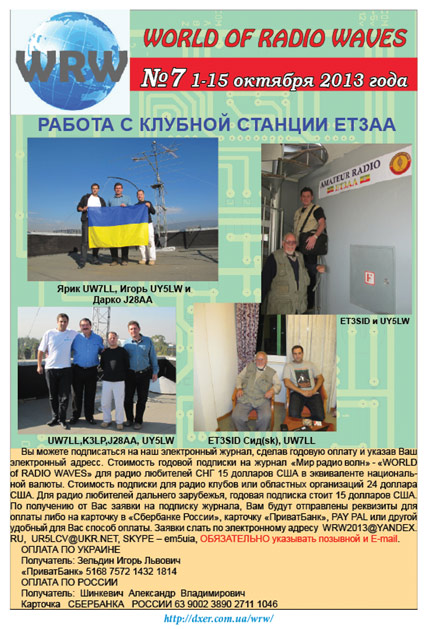| Меню сайта |
 |
 |
||||||
 |
журнал WORLD of RADIO WAVES
Добавлять комментарии могут только зарегистрированные пользователи. [ Регистрация | Вход ] |
 |
|||||
 |
 |
| Статистика |
|
Онлайн всего: 1 Гостей: 1 Пользователей: 0 |
Предлагаем Вашему вниманию журнал WORLD of RADIO WAVES. Журнал посвящен HAM-радио, и ориентирован на рускоговорящих радиолюбителей. Журнал выходит два раза в месяц, а подписаться на него можно с любого месяца (подписка календарно-месячная: то есть если вы подписались скажем с марта месяца, то вы будете получать все номера с марта текущего года по март следующего). Подробнее как оформить подписку можно прочитать на сайте WRW.
Журнал прекрасно иллюстрирован и содержит множество интересных материалов, фактов, фотографий, обзоров антенн и аппаратуры, а также можно прочитать об увлекательных экспедициях. Раньше мне очень нравился журнал «Радио», и я выписывал его ради нескольких страничек посвященных любительской связи. А теперь этому увлекательному делу посвящен целый журнал, объемом в 30 страниц!
Журнал выходит два раза в месяц, и выпускается в электронном виде в формате PDF по электронной почте подписчикам. Подписная цена на это издание не очень высока: 15 долларов США в год. То есть цена одного номера чисто символическая: 15 рублей. Это чашка кофе в кафе или пачка сигарет. Но можно потратить символическую сумму не на отраву, а на радиолюбительский журнал. Настоящий радиолюбитель выбирает журнал WORLD of RADIO WAVES! Вы можете скачать с моего сайта бесплатно для ознакомления №10 WORLD of RADIO WAVES, приятного чтения.
Комментарии
№1 июль 2013 Электронный
№1 июль 2013 Электронный журнал «МИР РАДИО» — «The World of Radio Waves»
Много ЯГ или один ромб?
В.Бензарь EU1AA, ex 5B4AGM, C4M стр.3
Проволочные антенны стр.5
Коротковолновые антенны
ВМС США стр.7
КВ усилитель мощности
В.Мельничук UR5YW стр.8
Новые горизонты старого
HAM-радио
А.Фёдоров RW3AH стр.11
ST2UU и его ковёр-самолет стр.16
Антенны VLF
Renato Romero IK1QFK стр.18
Синхронный приём
А.Анкудинов UA3VVM стр.19
Т-образная антенна
на 137кГц
ON7YD стр.20
IOTA стр.22
Модификация IC-7600
для подключения SDR
S.Wageber VE4NSA стр.23
ТРАНСИВЕРЫ
ANAN-10, ANAN 100
ConRADIO-18
FLEX 6000 стр.25
ДАЙДЖЕСТ стр.27
Справочный материал стр30
Приложение
«Люди и Коды» (продолжение)
В.Копейкин стр.31
- Войдите или зарегистрируйтесь, чтобы оставлять комментарии
№3 (август) 2013 Электронный
№3 (август) 2013 Электронный журнал «МИР РАДИО» — «The World of Radio Waves»
СОДЕРЖАНИЕ
Много ЯГ или один ромб?
В.Бензарь EU1AA, ex 5B4AGM, C4M стр.3
Ромбы W0AIH стр.7
Проволочные
антенны стр.9
Inverted L антенна
на 160М
Bob N4JTE стр.10
40-80 M GP вертикал
James «Jimmie» R Hilt II,
N8NSN стр.12
Победители CQWW DX и
CQWPX Contest’s c 1948
по 2012 гг. в категориях
M/M, M/S и SOAB. стр.14
ARRL анонсирует гранты
Colvin Awards для трёх
DX-peditions
T33A Banaba Island стр.17
K9W Wake Island стр.19
DX News стр.21
IOTA стр.22
Новый трансивер
IC-7100 стр.23
Сравнение Elecraft K3 с
ICOM IC-781, Kenwood
TS-850 стр.25
ДАЙДЖЕСТ
О.Ашмаров K0TF стр.29
Подробнее: http://www.rl.electronica.by
- Войдите или зарегистрируйтесь, чтобы оставлять комментарии
Начал рассылаться электронный
Начал рассылаться электронный журнал «Мир Радиоволн» — «World of Radio Waves». Журнал выходит два раза в месяц, объемом — 30 страниц формата А4. Будем признательны за проявленный интерес к нашему проекту.
Во вложении краткий анонс второго выпуска и условия подписки. Посмотреть домашнюю страницу журнала и ознакомится с содержанием предыдущих выпусков на— http://dxer.com.ua/wrw
С уважением,
В.Бензарь EU1AA
И.Зельдин UR5LCV
WRW3anons.pdf
- Войдите или зарегистрируйтесь, чтобы оставлять комментарии
СОДЕРЖАНИЕ
СОДЕРЖАНИЕ №5-09-2013
АНТЕННЫ
Проволочные антенны стр.3
Грозозащита любительских радиостан-ций стр.6
IOTA
Экспедиции
1-15 сентября стр.10
DX-NEWS
DX-news стр.13
УСИЛИТЕЛИ МОЩНОСТИ
КВ усилитель мощности KATANA-3K
Karl Brauchle DC9DZ стр.15
ПРЕСЕЛЕКТОРЫ
Преселектор
И.Подгорный EW1MM стр.17
ВЧ ТРАНСФОРМАТОРЫ
Изготовление балуна стр.21
УКВ ТРАНСИВЕРЫ
Модификация УКВ трансивера Baofeng UV-5R стр.24
КВ ТРАНСИВЕРЫ
Походные КВ QRPCW трансиверы стр.26
ЗАЗЕМЛЕНИЕ РАДИОСТАНЦИЙ
Как заземлитьсяв городе стр.29
- Войдите или зарегистрируйтесь, чтобы оставлять комментарии
СОДЕРЖАНИЕ № 6 (15-30
СОДЕРЖАНИЕ № 6 (15-30 сентября) 2013
ПЕРСОНА
R. LOUIS VARNEY G5RV стр.3
КВ ТРАНСИВЕРЫ
Китайские трансиверы стр.7
IOTA
Экспедиции 15-30 сентября стр.8
DX-NEWS
DX-news стр.10
Основной блок коммутации SO2R стр.12
УСИЛИТЕЛИ МОЩНОСТИ
DRESSLER TSUNAMI
Karl Brauchle DC9DZ стр.13
ГРОЗОЗАЩИТА
Грозозащита либительских радиостанций стр.15
ПРИЁМНИКИ ПРЯМОГО ПРЕОБРАЗОВАНИЯ
ППП с демодулятором Д. Уивера
Сергей Дылда US5QBR стр.19
НОВЫЕ РАЗРАБОТКИ
ЕН Антенна стр.27
ЭТО ИНТЕРЕСНО
Участники Слёта R3HD R3AA
RZ3CC UA3GC RX3AU стр.30
ПРИЛОЖЕНИЕ стр.29
- Войдите или зарегистрируйтесь, чтобы оставлять комментарии
СОДЕРЖАНИЕ №7 (1-15 октября
СОДЕРЖАНИЕ №7 (1-15 октября 2013)
ИСТОРИЯ
ИСТОРИЯ ARRL стр.3
КОМАНДА UW5Y
Любимый VHF contest.
Команда UW5Y в VHF
IARU-1 contest стр.8
ТРАП
Методика изготовления
и настройки трапов
от DK7ZB стр.16
ТРАНСФОРМАТОР
Трансформаторы тока
от W1JR стр.18
НОВОСТИ
Преселектор MJ1048 стр.19
ПРЕСЕЛЕКТОР
Преселектор на полосовых
фильтрах стр.21
IOTA
Новости IOTA стр.29
DX-NEWS
DX-news стр.30
- Войдите или зарегистрируйтесь, чтобы оставлять комментарии
СОДЕРЖАНИЕ №8 (15-30
СОДЕРЖАНИЕ №8 (15-30 октября 2013)
BIG GUNS
Big Guns — кто они? стр.3
КАРПАТЫ
Экспедиция в
Карпаты стр.10
НОВОСТИ
Новости – Alinco DXSR9 стр.11
Интерфейс звуковой карты
фирмы Fox стр.16
АНТЕНЫ
Антенны от DK7ZB стр.21
ПРЕСЕЛЕКТОР
Преселектор на полосовых
фильтрах стр.26
IOTA
Новости IOTA стр.30
DX-NEWS стр.31
- Войдите или зарегистрируйтесь, чтобы оставлять комментарии
Журнал «Мир радиоволн», 1-й
Журнал «Мир радиоволн», 1-й декабрьский номер
Содержание первого декабрьского номера журнала «Мир радиоволн»
- Гульельмо Маркони ( из книги Копейкина «Коды и люди» )
- Мой учитель U5NM
- Loren Windom W8GZ
- OCFD антенна
- Carolina Windom antenna
- Windom baluns
- Измеряем характеристики балуна
- Новости от Ameritron
- Новости от Tokyo HY Power
- Усилитель мощности на лампе ГУ78Б
- IOTA news
- DX news
- Войдите или зарегистрируйтесь, чтобы оставлять комментарии
- Если вы новый пользователь ресурса LAN23, прочтите Правила (FAQ). Вы должны зарегистрироваться прежде, чем оставлять свои сообщения на форуме. Регистрация на форуме не автоматическая — проходит проверку модераторами, поэтому наберитесь терпения.
На форуме запрещен обмен fullflash [дампы с любых устройств, содержащих уникальную информацию, позволяющую идентифицировать устройство в сети] и прямые ссылки в сообщениях на сторонние ресурсы, если это не ресурсы рекламодателей.
Обработка…
Время на прочтение
3 мин
Количество просмотров 34K
Начиная с декабря прошлого года, мы выпускаем интернет-радиоприемники Wolna-2 в Санкт-Петербурге. Это уже вторая модель, в которой мы учли большинство пожеланий пользователей. Кому интересно что за зверь — отечественное интернет-радио, добро пожаловать под кат!
В этой статье я сначала опишу основные функции, а потом немного пройдусь по внутрянке и ключевым решениям по железу.
А что оно могёт?
А может оно ровным счетом то, что от него требуется. То есть проигрывать онлайн потоки громко и четко. Кстати, приемник стереофонический, и не смотря на небольшую стереобазу ощущение объемного звучания присутствует. Встроенный эквалайзер позволяет получить неплохую для таких размеров окраску звука. Есть линейный выход для внешней АС.
Радиостанции:
Потоки живут в двух списках: список пользователя, и список производителя.
В списке производителя около 100 радиостанций России, и они постоянно добавляются. Обновить их можно прямо через меню приемника. Это позволяет тем, кто не хочет заморачиваться с вводом потоков найти себе радиостанции по душе.
Второй список- пользовательский. Тут уже есть где разгуляться настоящим фанатам интернет-радио. В приемник можно добавить до 1000 собственных потоков. Делается это при прямо через меню приемника. Так же, можно делать это через вэб-интерфейс, например со смартфона.
Вэб интерфейс
Недавно мы наконец-то реализовали вэб-интерфейс для добавления станций, и управления воспроизведением. Пока что он простенький, но уже сильно облегчает жизнь тем, кто добавляет много потоков, и кому лень встать с дивана чтобы переключить станцию. Со временем планируем превратить эту фичу в полноценный пульт управления.
Встроенная батарея
В приемнике имеется встроенная батарея на 1500 мАч. Это элемент 18650, и он впаян намертво. Хватает примерно на 3 часа работы на средней громкости. Если, например, использовать приемник как стример для внешней АС, то хватает часов на 6 с учетом того, что громкость самого приемника на минимуме.
А что внутри? гик порнушка
Сердцем аппаратной части стал свежий камушек ESP32. И если вы спросите меня, на сколько я оцениваю этот микроконтроллер, то я скажу 11 из 10! Это бомба! При стоимости модуля с разведенной RF частью в 250 рублей они имеет 2 ядра по 240 МГц, 500 к RAM и флешку на 4 мегабайта. да еще и встроенный wifi и bluetooth. О нем я обязательно напишу отдельную статью.
Декодер аудио все тот же — VS1053, обеспечивает прекрасный звук, при этом прост в управлении. Он пожалуй уже стал классикой для всех микроконтроллерных приложений, связанных с mp3.
Решено было взять готовый модуль с обвязкой, это позволяет серьезно сократить номенклатуру комплектующих, а так же сэкономить на запайке. Подход себя оправдал, поэтому зарядка АКБ, дисплей и модуль усилителя тоже модульные. Получилась вот такая вот платка-гибрид:
В разъемы втыкаются дисплей с энкодером и усилитель.
Отдельно хочется рассказать о подходе с использованием готовых модулей. Можно сказать, что он стал одним из драйверов роста, позволив оптимизировать производство. В несколько раз сократились:
— номенклатура комплектующих → затраты на логистику
— работа по запайке
— процент брака (видимо их все таки проверяют перед тем как отправлять)
О софтовой части могу написать отдельно. Повторюсь, микроконтроллер очень прост в освоении, думаю многим будет интересно. Например, от первого мигания светодиодом до подключения к WiFi у меня прошло часа два. А на следующий день я уже спокойно обменивался данными с TCP сервером.
В конце, прикреплю маленький обзор. Ругать, как обычно в комментах:) Если бы по мне не прошлись как следует в комментариях пол года назад, не было наверно ни какой второй версии, так что рад любым мыслям!
FTC disclaimer: This post contains affiliate links and I will be compensated if you make a purchase after clicking on my link.
We know that radio wave is transmitted over the air to carry information from one node to another node in networking.
But, we don’t clearly know how radio wave is propagated and how it reacts within an environment.
During propagation, radio waves go through many obstacles or obstructions, which may impact the overall range and performance of the wave.
While installing and troubleshooting WLANs, it is good to know how radio waves have complexities and limitations.
Understanding Radio waves basics
Most wireless technology such as Wi-Fi, GPRS, Bluetooth, and GPS utilizes radio waves to transmit signals from one node to another node.
What are Radio waves?
Radio waves are electromagnetic waves that can propagate through a different medium with wavelength and frequency ranges in the electromagnetic spectrum.
The propagation of radio waves can be through air, liquid, vacuum, or even solids.
Also, radio waves are referred to as Radio Frequency (RF) signals.
In addition, radio waves are the primary means to carry data over the wireless network.
Moreover, the radio waves are mathematically depicted as a sinusoidal waves.
The distance covered to complete one cycle of the sine wave is called wavelength. The height (or vertical distance) from the axis of the radio wave, namely the reach of maximum (or minimum) value, is called Amplitude.
Moreover, the number of the full cycle (complete sine wave) covered in a second is known as frequency.
The frequency is measured in Hertz (Hz) or cycles per second.
Let’s look into the deeper aspect of various attributes of radio waves.
Attributes of Radio waves
As we know that Radio waves are the primary means to carry information from one point to another point.
But how is the information represented before it was transmitted through a medium like air?
The information in radio waves is represented by varying the following attributes with time.
- Amplitude
- Frequency
- Phase
Amplitude
The amplitude in the Radio wave indicates its strength and power. It indicates to what distance the radio wave can travel.
In other words, the amplitude of a Radio wave or any electromagnetic wave determines the height, force, power, and strength of the signal.
Further, it also defines the possible range of the wave according to its power and strength.
You can determine the wave’s amplitude by keeping the other factors like frequency, cycle, and wavelength constant.
So, if the wave has higher power or amplitude, then the peeks of the wave will be higher. And, if the wave has lower power or amplitude, then the peeks of the wave will be lower.
Frequency
The frequency in the Radio wave is the number of occurrences of a repeating wave (sine wave) per unit of time.
In other words, frequency in a Radio wave is the number of cycles undergone during one unit of time.
Frequency in the electromagnetic wave is also stated as something that happens again and again. It is something that frequently occurs, consistently, and repetitive.
Moreover, the frequency is measured in Hertz (Hz), which denotes the number of cycles occurring per second. Earlier, frequency is represented as cycles per second (cps).
One cycle representing the specified event is measured in one second, equal to 1 Hz. So, if 5 cycles are measured in one second, then it is equal to 5 Hz.
In IEEE 802.11 Wireless LAN, it uses Radio waves with 2.4 GHz and 5 GHz frequency. It means that signal can have 2,400,000,000 cycles per second and 5,000,000,000 cycles per second, respectively.
Additionally, the signal at these frequencies is not audible and visible to humans.
Further, the frequency can impact the propagation of Radio waves. The higher frequency signal can have a smaller range than the lower frequency signal.
But, if the transmission power of a higher frequency signal is more than a lower frequency signal, then the signal may travel far.
Phase
The phase of the Radio wave is defined when two or more wave is a form of the same frequency, same wavelength and of the same cycle but are not exactly aligned with each other.
So, Phase is not because of one RF signal, but there is an involvement of two or more RF signals that share the same frequency. Further, the Phase shows the relationship of the amplitude of two waveforms.
The Phase affects amplitude when we receive two or more radio waves. If multiple signals have a zero (0) degree phase, then the wave’s amplitude is combined to form the wave of greater strength.
If the multiple signals have a 180-degree phase, then the amplitude of the waves cancel each other out to form a signal of strength null.
So, the phase separation has a cumulative effect on signals, and it depends on the degree of the phase separation that determines the signal strength either increased or diminished.
For instance, if the two waveforms are 180 degrees out of phase or the phase difference of 180, then the two waves will cancel each other.
Radio Waves Modulation
As we have stated that Radio waves carry data in the form of the sine wave. Further, the Radio wave can be transmitted from one end and received at the other end.
The transmitted data (such as audio or video) can be received only when the receiver matches it with the same frequency.
Also, the receiver examines the frequency or amplitude of the radio wave to get the transmitted data.
To understand better, you need to know how radio waves carry data. The radio wave that carries data is known as a radio carrier wave.
The process of modifying radio carrier waves using information such as audio or video is called Radio modulation.
The radio waves can carry data mainly in two ways.
- Amplitude Modulation
- Frequency Modulation
- Phase Modulation
Amplitude Modulation
Amplitude modulation is a type of modulation in which the radio carrier wave is modified by varying amplitude (intensity).
Frequency Modulation
Frequency modulation is a type of modulation in which the radio carrier wave carrying information signal is modified by varying frequency.
The slight change in frequency represents different values it is carrying using a radio carrier wave.
The most common household equipment that uses Frequency Modulation (FM) is cordless phones, television, and mobile phone.
Phase Modulation
The phase modulation occurs by varying the phase of the carrier in line with the modulating signal.
Moreover, phase modulation has grown rapidly over recent years for data transmission. Also, phase modulation and frequency modulation has certain similarities that make them eligible for data communication.
Radio Frequency Spectrum
The FCC (Federal Communication Commission) regulates various radio frequencies and their uses. It is divided into different bands, and each band has a range of frequencies.
The frequency range of radio waves
- Extremely Low Frequency (ELF): Less than 3 kHz and wavelength greater than 100 km
- Very Low Frequency (VLF): 3 kHz to 30 kHz and wavelength is in between 10 to 100 km
- Low Frequency (LF): 30 kHz to 300 kHz and wavelength is in between 1m to 10 km
- Medium Frequency (MF): 300 kHz to 3 MHz and wavelength is in between 100 m to 1 km
- High Frequency (HF): 3 MHz to 30 MHz and wavelength is in between 10 to 100 m
- Very High Frequency (VHF): 30 MHz to 328.6 MHz and wavelength is in between 1 to 10 m
- Ultra-High Frequency (UHF): 328.6 MHz to 2.9 GHz and wavelength is in between 10 cm to 1 m
- Super High Frequency (SHF): 2.9 GHz to 30 GHz and wavelength is in between 1 to 1 cm
- Extremely High Frequency (EHF): 30 GHz to 300 GHz and wavelength is in between 1 mm to 1 cm
Types of Radio waves
Types of Radio waves are:
Low to Medium Frequency range of radio waves
Extremely Low Frequency (ELF) radio waves have the least frequency in radio waves and have a long range.
The extremely low frequency and long wavelength of radio waves are extremely important to penetrate water and rock. It is useful in communication with submarines and inside mines and caves.
The natural source of ELF/VLF radio waves is lightning.
However, the low frequency (LF) and medium frequency (MF) radio waves are used in marine and aviation radio just as commercial AM radio.
Higher Frequency range of radio waves
The higher frequency range of radio waves includes HF, VHF, and UHF. These higher frequency ranges of radio waves are used in radio, television communication, cellphones, and GPS.
This group of radio waves uses frequency modulation to bring excellent quality and not get affected by ecological components.
Shortwave Frequency range of radio waves
Short radio waves are formed by using the frequency in the HF band, from 1.7 MHz to 30 MHz.
It is mostly utilized in international broadcasting and to relay telephone and telegraph communication over great distances in ordinary telecom stations.
Highest Frequency range of radio waves
Super High Frequency (SHF) and Extremely High Frequency (EHF) radio waves can carry an enormous amount of data. It is mostly used in radar, satellite communication, and terrestrial communication.
Some of the common radio devices use radio waves and their frequency range.
- AM radio: 535 kHz to 1.705 MHz
- Short wave radio: 5.95 MHz to 26.1 MHz
- Television stations (channels 2 through 6): 54 to 88 MHz
- FM radio: 88 MHz to 108 MHz
- Television stations (channels 7 through 13): 174 to 216 MHz
- Cordless phones: ~ 900 MHz, ~ 2.4 GHz, ~ 5 GHz
- Global Positioning Systems (GPS): 1.2276 and 1.57542 GHz
Radio wave behavior
The behavior pattern of radio waves exhibits when they come in contact with objects.
We will look at how the behavior pattern change when it comes to contact with objects.
Reflection
Reflection occurs in a radio wave when a radio wave hits an object larger than its wavelength. In such cases, the radio wave is reflected off the surface.
Refraction
Refraction occurs in a radio wave when a radio wave travels from low density to higher density medium.
In the case of refraction, the radio wave is changed to a different angle. The most common example is that when it travels through the cloud.
Scattering
Scattering occurs when the radio wave hits the rough surface or irregular surface and bounces off the surface in multiple directions.
Absorption
Absorption occurs when the radio wave is lost because it is not reflected, refracted, and scattered from the object.
Diffraction
Diffraction occurs when an object in its path blocks the radio wave, then it is broken up and bends around the corner of the object.
Conclusion
The radio wave is most common for wireless communication by transmitting and receiving the modulated signal.
It is used in every aspect of our daily lives, such as AM or FM radio, mobiles, television, and more.
Moreover, complex technologies have improved the encoding capabilities of electromagnetic signals. Also, it improves the quality of information collected and secures the overall transmission.
-
Defenition of the word radio wave
- an electromagnetic wave with a wavelength between 0.5 cm to 30,000 m
Synonyms for the word radio wave
-
- radio emission
- radio radiation
Meronymys for the word radio wave
-
- radio spectrum
- radio-frequency spectrum
Hyponyms for the word radio wave
-
- carrier
- carrier wave
- ground wave
- long wave
- medium wave
- radio signal
- short wave
- sky wave
Hypernyms for the word radio wave
-
- electromagnetic radiation
- electromagnetic wave
- nonparticulate radiation
See other words
-
- What is radio receiver
- The definition of radio observation
- The interpretation of the word radio noise
- What is meant by radio news
- The lexical meaning radio link
- The dictionary meaning of the word radio interferometer
- The grammatical meaning of the word radio frequency
- Meaning of the word radio compass
- Literal and figurative meaning of the word radio chassis
- The origin of the word radio emission
- Synonym for the word radio radiation
- Antonyms for the word raphanus sativus
- Homonyms for the word radish plant
- Hyponyms for the word atomic number 88
- Holonyms for the word radium therapy
- Hypernyms for the word r
- Proverbs and sayings for the word radius vector
- Translation of the word in other languages radome

